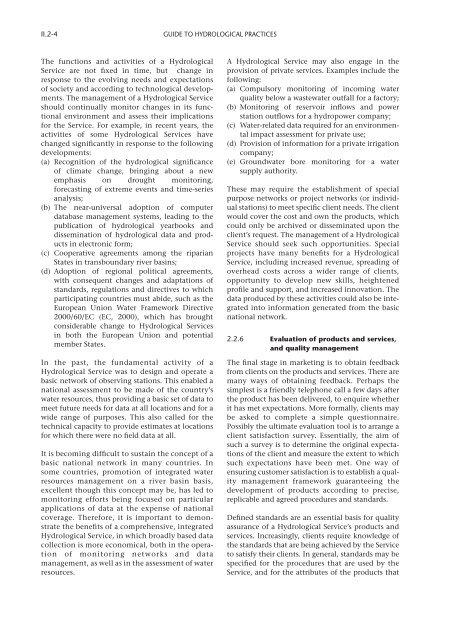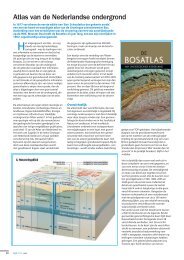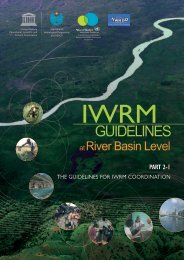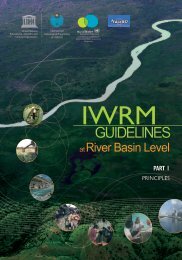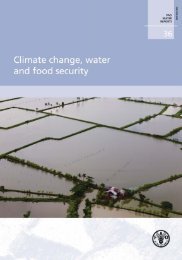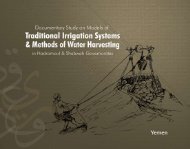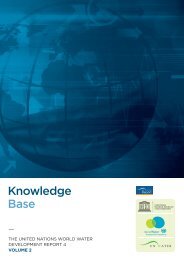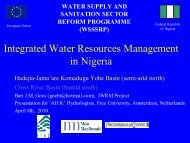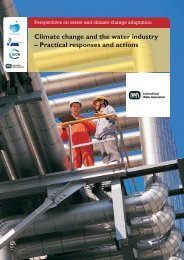Guide to Hydrological Practices, 6th edition, Volume II - Hydrology.nl
Guide to Hydrological Practices, 6th edition, Volume II - Hydrology.nl
Guide to Hydrological Practices, 6th edition, Volume II - Hydrology.nl
Create successful ePaper yourself
Turn your PDF publications into a flip-book with our unique Google optimized e-Paper software.
<strong>II</strong>.2-4GUIDE TO HYDROLOGICAL PRACTICESThe functions and activities of a <strong>Hydrological</strong>Service are not fixed in time, but change inresponse <strong>to</strong> the evolving needs and expectationsof society and according <strong>to</strong> technological developments.The management of a <strong>Hydrological</strong> Serviceshould continually moni<strong>to</strong>r changes in its functionalenvironment and assess their implicationsfor the Service. For example, in recent years, theactivities of some <strong>Hydrological</strong> Services havechanged significantly in response <strong>to</strong> the followingdevelopments:(a) Recognition of the hydrological significanceof climate change, bringing about a newemphasis on drought moni<strong>to</strong>ring,forecasting of extreme events and time-seriesanalysis;(b) The near-universal adoption of computerdatabase management systems, leading <strong>to</strong> thepublication of hydrological yearbooks anddissemination of hydrological data and productsin electronic form;(c) Cooperative agreements among the riparianStates in transboundary river basins;(d) Adoption of regional political agreements,with consequent changes and adaptations ofstandards, regulations and directives <strong>to</strong> whichparticipating countries must abide, such as theEuropean Union Water Framework Directive2000/60/EC (EC, 2000), which has broughtconsiderable change <strong>to</strong> <strong>Hydrological</strong> Servicesin both the European Union and potentialmember States.In the past, the fundamental activity of a<strong>Hydrological</strong> Service was <strong>to</strong> design and operate abasic network of observing stations. This enabled anational assessment <strong>to</strong> be made of the country’swater resources, thus providing a basic set of data <strong>to</strong>meet future needs for data at all locations and for awide range of purposes. This also called for thetechnical capacity <strong>to</strong> provide estimates at locationsfor which there were no field data at all.It is becoming difficult <strong>to</strong> sustain the concept of abasic national network in many countries. Insome countries, promotion of integrated waterresources management on a river basin basis,excellent though this concept may be, has led <strong>to</strong>moni<strong>to</strong>ring efforts being focused on particularapplications of data at the expense of nationalcoverage. Therefore, it is important <strong>to</strong> demonstratethe benefits of a comprehensive, integrated<strong>Hydrological</strong> Service, in which broadly based datacollection is more economical, both in the operationof moni<strong>to</strong>ring networks and datamanagement, as well as in the assessment of waterresources.A <strong>Hydrological</strong> Service may also engage in theprovision of private services. Examples include thefollowing:(a) Compulsory moni<strong>to</strong>ring of incoming waterquality below a wastewater outfall for a fac<strong>to</strong>ry;(b) Moni<strong>to</strong>ring of reservoir inflows and powerstation outflows for a hydropower company;(c) Water-related data required for an environmentalimpact assessment for private use;(d) Provision of information for a private irrigationcompany;(e) Groundwater bore moni<strong>to</strong>ring for a watersupply authority.These may require the establishment of specialpurpose networks or project networks (or individualstations) <strong>to</strong> meet specific client needs. The clientwould cover the cost and own the products, whichcould o<strong>nl</strong>y be archived or disseminated upon theclient’s request. The management of a <strong>Hydrological</strong>Service should seek such opportunities. Specialprojects have many benefits for a <strong>Hydrological</strong>Service, including increased revenue, spreading ofoverhead costs across a wider range of clients,opportunity <strong>to</strong> develop new skills, heightenedprofile and support, and increased innovation. Thedata produced by these activities could also be integratedin<strong>to</strong> information generated from the basicnational network.2.2.6 Evaluation of products and services,and quality managementThe final stage in marketing is <strong>to</strong> obtain feedbackfrom clients on the products and services. There aremany ways of obtaining feedback. Perhaps thesimplest is a friendly telephone call a few days afterthe product has been delivered, <strong>to</strong> enquire whetherit has met expectations. More formally, clients maybe asked <strong>to</strong> complete a simple questionnaire.Possibly the ultimate evaluation <strong>to</strong>ol is <strong>to</strong> arrange aclient satisfaction survey. Essentially, the aim ofsuch a survey is <strong>to</strong> determine the original expectationsof the client and measure the extent <strong>to</strong> whichsuch expectations have been met. One way ofensuring cus<strong>to</strong>mer satisfaction is <strong>to</strong> establish a qualitymanagement framework guaranteeing thedevelopment of products according <strong>to</strong> precise,replicable and agreed procedures and standards.Defined standards are an essential basis for qualityassurance of a <strong>Hydrological</strong> Service’s products andservices. Increasingly, clients require knowledge ofthe standards that are being achieved by the Service<strong>to</strong> satisfy their clients. In general, standards may bespecified for the procedures that are used by theService, and for the attributes of the products that


